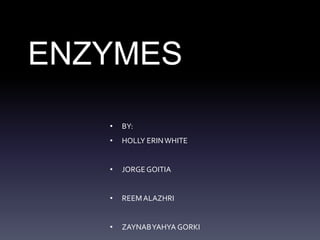
Enzmes
- 1. ENZYMES • BY: • HOLLY ERIN WHITE • JORGE GOITIA • REEM ALAZHRI • ZAYNAB YAHYA GORKI
- 2. What are Enzymes? • Enzymes are biological catalysts made of protein.
- 3. What are Catalyst? • A catalyst is a substance, which can alter or speed up a chemical reaction, without itself being chemically changed at the end of the reaction. •
- 4. • Digestion is an enzyme-catalyzed process. Some food molecules are large and insoluble in water; these molecules cannot diffuse through the cell surface membrane. Imagine a meal consisting of fish and rice: • Rice contains starch, a very large carbohydrate molecule. • Fish contain two types of large molecules: protein and fats. What reaction do Enzyme Catalyze?
- 5. •EXPERIMENT The effect of Catalase on Hydrogen Peroxide.
- 6. • Catalase is an enzyme found in many plant and animal tissues. The enzyme has the function of breaking down dangerous peroxide ions. As it does, oxygen gas is released –because the reaction is rapid, the oxygen bubbles form froth on the top of a reacting solution. INTRODUCTION!
- 7. • 1. The temperature of the surroundings and test tubes • 2. The pH value of its surroundings • 3. The substrate volume • 4. Mass of enzyme used In the experiment the key factors that could affect the results o f the Experiment will be:
- 8. • To determine the effect of catalase on hydrogen peroxide. • To conduct the experiment correctly. • To gather appropriate data for analysis and conclusion. OBJECTIVES:
- 9. • Hydrogen peroxide • Test tubes • Potatoes • Egg white • Yeast • Wooden splint • Graduated cylinder • Knife • Chopping board • Beaker • String spoon MATERIALS:
- 10. PROCEUDRE: • Gather all the needing materials. • Peal one potato and cut it in small pieces, get the beaker and pour the cutting potatoes into, then boil it. • Peal one potato again and cut it in small pieces. • Break your egg white and pour it into the beaker • Measure 10ml of hydrogen peroxide into each test tube or boiling tubes. • Label each test tube A, B, C, D. • To each test tube, add one of the following substances: A. some chopped raw potato, B. egg white, C. some chopped boiled potato, D. some yeast. • Place each test tube in the test tube keeper. • Gently observed the experiment • Record your observation, and explain them as fully as you can.
- 11. A. Raw potato: we think that the enzyme will react greater with the potato and produce More froth when it is cut up. This is because as you cut it up into smaller bits, you make the Surface area greater meaning there are more enzymes to react with each Other, and there will be more successful collisions between the two Reactants. B. Boiled egg white: when the egg was drop in hydrogen the ph value increase that is why it produced a lot of bubble and the enzyme speed up faster. C. Boiled potato: during the process of boiled potato there was no reaction or bubble this was due to the lack of Enzymes that was already burn when boiling. E. Yeast: This is always happening but at a very low rate so you don't notice it. If you add yeast to hydrogen peroxide it will speed up the decomposition of H2O2. However the yeast does not react with the H2O2 and nothing is chemically altered in the yeast. That is because yeast is a catalyst. ANALYSIS AND INTERPRETATION OF DATA:
- 12. TUBE CONTENT HIEHT OF FROTH IN ONE MINUTE(CM) A RAW POTATOES 9.8CM B BOILED EGG WHITE 1CM C BOILED POTATOES NOTHING D YEAST 9CM DATA:
- 13. A. Raw Potatoes :the raw potatoes produced many bubble and the enzymes speed up faster. B. Boiled Egg White: The boiled egg white actually have bubble but the speed of the enzymes was quite slow this is because of the PH value . C. Boiled Potatoes: The boiled egg has not reaction or produced anything this is because the enzymes are already broken down. D. Yeast: The yeast reaction to the hydrogen peroxide has a greater decomposition but a very low rate. Many bubble present. OBSERVATION:
- 14. • CONCLUSION: how enzymes With todays experiment we quite learn and observed factors affect different substances. And we do hope that this lesson will never skip out of our memories.
